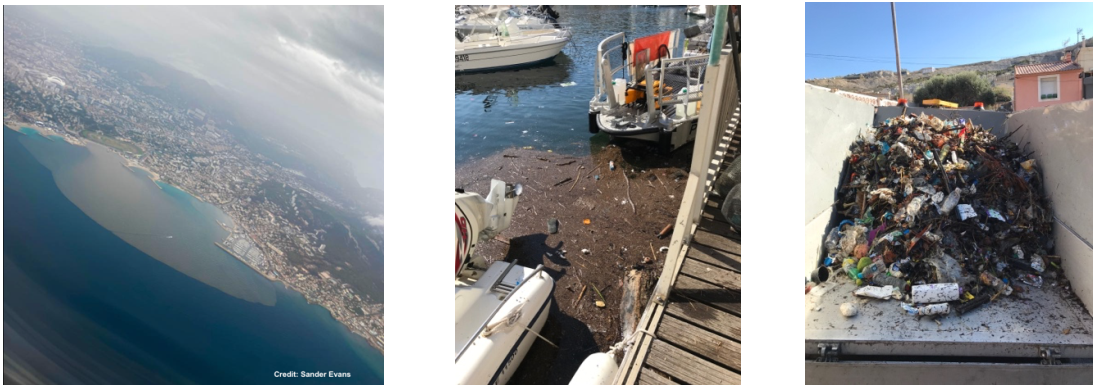La problématique des déchets flottants en mer est directement liée aux activités humaines à terre, pas seulement les activités proches des littoraux mais aussi celles qui en sont éloignées. En matière de déchets, la mer commence loin du rivage: dans les terres où les ruisseaux, rivières et fleuves peuvent en transporter une quantité importante qui va se jeter dans les mers. Comme on le voit souvent sur les bouches d’égout en ville, « la mer commence ici ». C’est ainsi que les experts et scientifiques s’accordent à dire que 80% des déchets marins proviennent des déchets terrestres.
Si le volume total de déchets rejetés dans les océans par an reste un chiffre controversé entre scientifiques, entre 12 Millions de tonnes et 0,5 Millions de tonnes, il n’en reste pas moins que chaque déchet plastique rejeté dans l’environnement représente un danger pour la faune mais aussi pour la santé publique.
Ainsi, l’orage ou la tempête dans les régions Lyonnaise, Toulousaine ou Parisienne sont susceptibles de créer une crise de pollution plastique en Méditerranée, Atlantique ou Manche.
Ces phénomènes météorologiques extrêmes ayant tendance à être plus fréquents avec le changement climatique, on peut s’attendre à plus de pollutions apportées par les fleuves.
Les littoraux, et en particulier, le littoral Méditerranéen, sont doublement impactés : non seulement ils reçoivent les déchets des fleuves et des activités industriels à proximité, mais aussi des autres littoraux plus éloignés: les ports de la région Sud connaissent bien les accumulations de déchets après des coups de vent d’Est qui amènent les déchets des côtes Italiennes, ou après les coups de Libecciu qui échouent les déchets marins venus du continent sur les côtes de la Balagne.
Ainsi, à l’heure du changement climatique et du redoublement de phénomènes météorologiques violents, le lien entre météorologie et pollution marine apparaît encore plus criant.
Arrivée massive d’eaux pluviales chargées en déchets et végétaux de la rivière huveaune qui se jette dans la rade de Marseille après les orages d’Octobre 2021

La Méditerranée cumule d’entrée de jeu des facteurs défavorables qu’ils soient géographiques (estuaires de grands fleuves, masse d’eau renouvelée sur un siècle, nombreux courants de surface), démographiques (très forte et constante hausse de la densité de population en zone littorale) , économiques (concentration d’activités humaines potentiellement polluantes dans ces mêmes zones littorales).
Si on regarde du côté de la météo…
Espagne, France, Italie, Grèce, Libye, … Les régions bordant la Méditerranée sont régulièrement touchées par des épisodes pluvieux extrêmement violents, comme les « épisodes cévenols ». Les reliefs abrupts et les systèmes orageux sont les causes principales de ces situations météorologiques particulières, qui provoquent ruissellement, crues, inondations, voire glissements de terrains. Les crues acheminent systématiquement jusqu’aux embouchures d’immenses quantités de déchets. Ces phénomènes sont récurrents et souvent, les mêmes zones sont touchées d’une année à l’autre. La vallée de la Roya en est un parfait exemple. Trois ans après les inondations dramatiques du 2 Octobre 2020, un épisode méditerranéen a de nouveau affecté les mêmes localités, notamment Saint-Martin-Vésubie.
Les études montrent, depuis 50 ans, une intensification des épisodes méditerranéens et une augmentation de la fréquence de ces épisodes les plus forts. Il est établi que les phénomènes orageux à leur origine s’alimentent en présence de masse d’air froid sur une mer chaude, typiquement ce qui se produit en automne.
La température de la mer est ainsi un élément clé dans ces épisodes pluvieux. D’après le Centre National de Recherches Météorologiques (CNRM), la température de la Méditerranée aura augmenté en surface d’ici la fin du siècle de 2 à 4 °C. Ainsi, il n’y a que peu de doute sur l’augmentation de la fréquence des événements climatiques extrêmes en Méditerranée.
Augmentation de la température en surface de la Méditerranée.

Les volumes de déchets arrivant en mer vont inévitablement suivre la même tendance. Alors, que faisons-nous ?
Les plastiques sont les déchets les plus nombreux et les plus polluants. En diminuer l’usage et la production, paraît la voie la plus censée. Malgré tout, réduire la production d’une industrie mondiale qui représente plus de 700 Milliards de Dollar en 2023, avec une progression estimée à 4% par an, n’est pas une mince affaire, voire impossible. Alors, comment pouvons-nous agir ? Il est possible d’améliorer la gestion des déchets à terre. Il est possible de faire en sorte qu’une grande partie des déchets qui partent dans les fleuves et les émissaires pluviaux, soit captée par les différentes technologies existantes. Filets, barrages, aspirateurs de surface : la palette d’outils, simples et lowtech est suffisamment large pour que les déchets n’aient pas le temps de partir naviguer et de sombrer au large.
Agissons !
Sources :
- Rapport parlementaire n° 217 “Pollution plastique : une bombe à retardement ?”
- https://www.senat.fr/rap/r20-217/r20-217.html
- https://www.umr-cnrm.fr/?lang=fr
- https://www.keraunos.org/




No responses yet